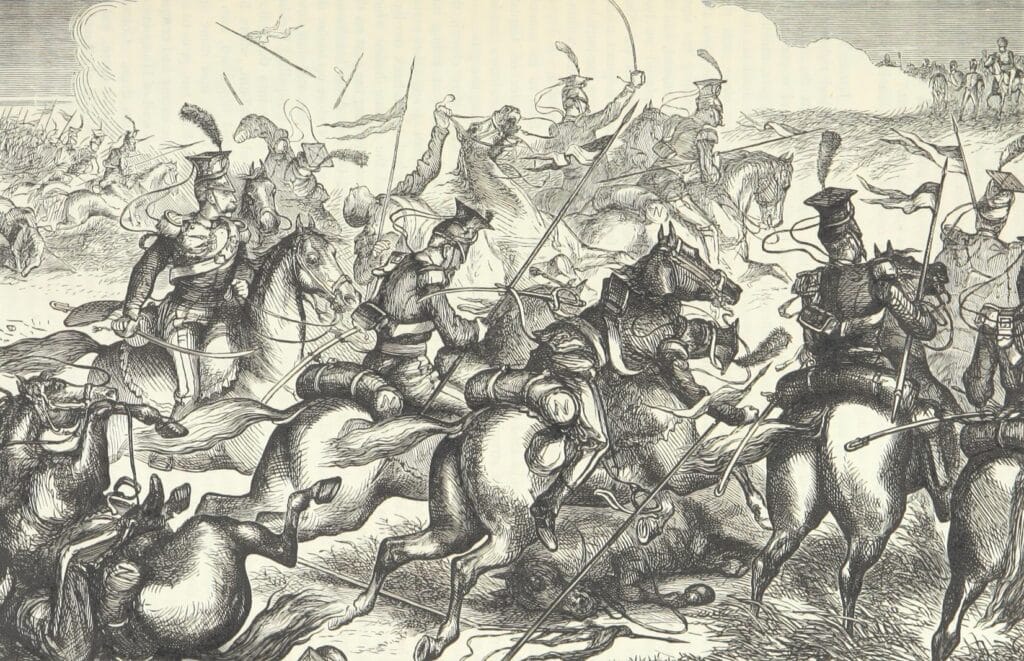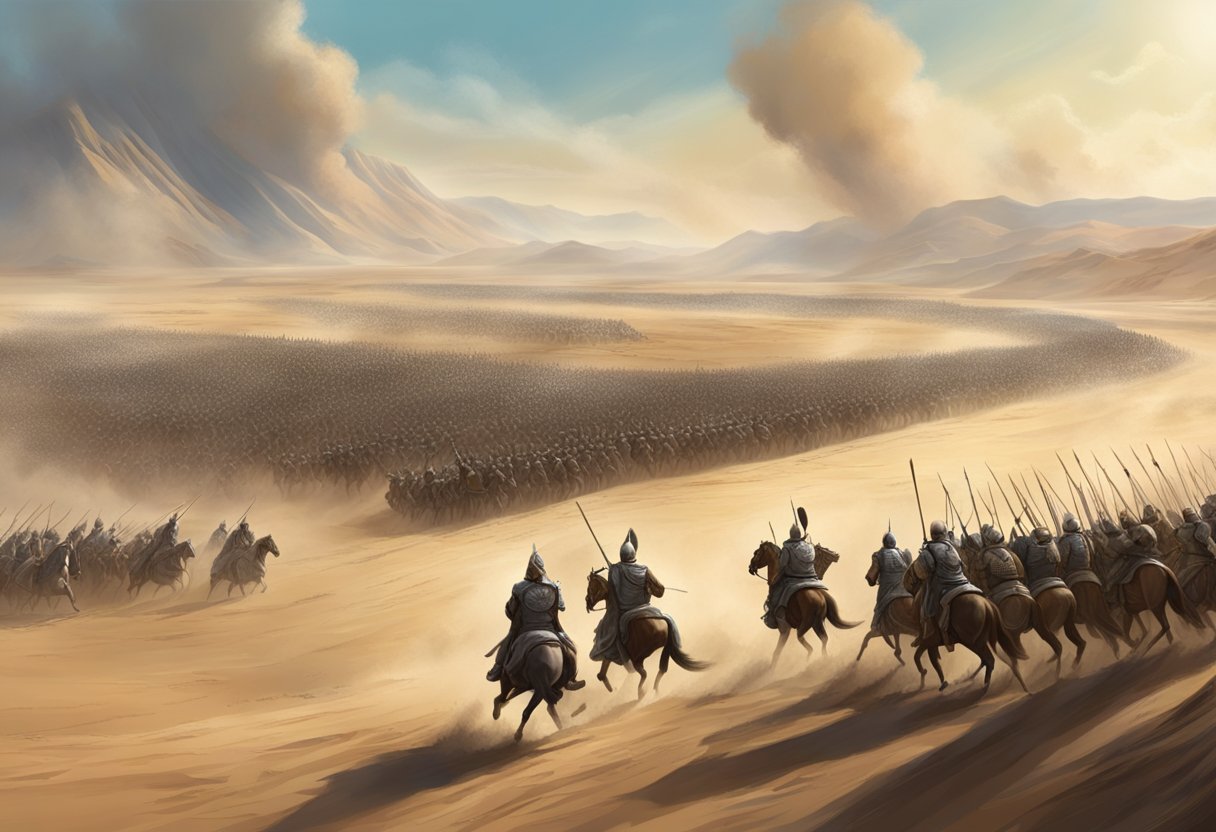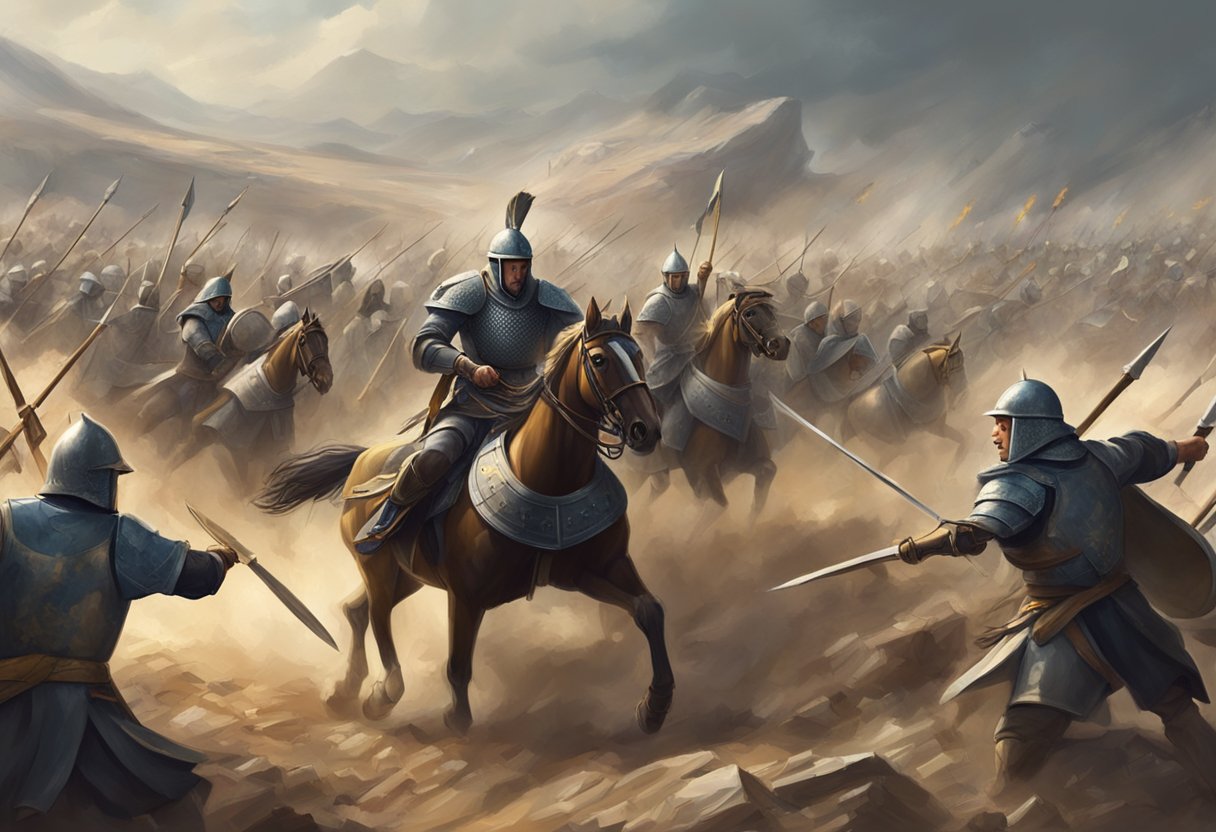The Battle of Carrhae, a decisive confrontation between the Roman Republic and the Parthian Empire, occurred in May 53 BC near the town of Carrhae (present-day Harran, Turkey). Marcus Licinius Crassus, one of the wealthiest Romans and a member of the First Triumvirate, led the Roman forces against the Parthians, commanded by General Surena. This battle is renowned for its significant impact on Roman military history, owing to the advanced tactics used by the Parthians and the resulting heavy losses experienced by the Roman legions.

Crassus’ ambitions to match the military achievements of his allies, Julius Caesar and Pompey the Great, pushed him to invade Parthia. The use of heavy cavalry and horse archers by the Parthians played a pivotal role in decimating the Roman legions. With the subsequent death of Publius Crassus, the son of Marcus Crassus, the battle not only led to a serious military defeat for the Romans but also marked the beginning of the end for Crassus’ political aspirations and the First Triumvirate. The implications of the Battle of Carrhae resonated through Roman and Parthian history, influencing their future relations and military strategies.
Key Takeaways
- The Battle of Carrhae was a major military conflict between the Roman Republic and the Parthian Empire, resulting in a significant Roman defeat.
- Marcus Licinius Crassus led the Roman forces and suffered a devastating loss due to the effective Parthian cavalry and archery tactics.
- The battle had lasting effects on Roman military tactics and amplified the tensions within the Roman political hierarchy.
Historical Context
The Battle of Carrhae stands as a pivotal event highlighting the political intrigue of Rome and the ascendancy of Parthia. This context sets the stage for the infamous conflict that had far-reaching implications for both empires.
Roman Political Climate
The First Triumvirate, an unofficial political alliance between Julius Caesar, Pompey, and Crassus, sought to dominate Roman politics. Each member had his own ambitions: Caesar sought military glory and expansion, Pompey coveted recognition and prestige, and Crassus, the wealthiest man in Rome, yearned for military achievements comparable to his political rivals. This alliance was as tenuous as it was powerful, ultimately setting the stage for conflict as each member vied for greater control and influence within Rome.
Rise of the Parthian Empire
At the same time, the Parthian Empire was experiencing a rise in power, capturing territory and exerting influence across the region. As Rome expanded its borders, it inevitably came into contact with Parthian territories, creating a new front for potential conflict. The Parthians boasted a formidable military, with cavalry archers that would prove to be a challenge for the heavy infantry tactics of the Roman legions.
Regional Tensions and Power Dynamics
In the lead-up to Carrhae, Rome’s expansion and the growing might of the Parthian Empire heightened regional tensions. Crassus, motivated by wealth and the desire for military triumph, led his legions into Parthian territory, underestimating the complexities of local power dynamics and the capabilities of the Parthian army. His actions not only catalyzed a significant military confrontation but also exacerbated the fragile equilibrium between Rome and its eastern neighbor.
Prelude to the Battle

In the events leading up to the Battle of Carrhae, Crassus’s ambition for wealth and military glory set the stage for one of the most significant confrontations between the Roman Republic and the Parthian Empire. This section explores Crassus’s motivations, the strategic and logistical efforts preceding the battle, and the diplomatic engagements that influenced its outset.
Crassus’s Motivations
Marcus Licinius Crassus, widely regarded for his immense wealth, sought not only to increase his fortunes but also to secure a military triumph to match that of his rivals, Pompey and Julius Caesar. His greed, combined with a desire for a lasting legacy in Roman history, fueled his decision to wage war on the powerful Parthian Empire.
Preparations and March to Carrhae
Crassus mobilized seven legions and a substantial body of cavalry, amassing an army to venture eastward from Syria towards Mesopotamia. His journey through the unforgiving desert terrain tested the endurance of his forces, but he pressed on, intent on capturing the wealth of the Parthian territories.
Alliances and Diplomacy
Efforts to secure alliances proved difficult for Crassus. He failed to fully convince the king of Armenia, Artavasdes, to support his campaign with heavy cavalry, which would have been crucial against the mounted archers of the Parthians. This lack of support significantly undermined his tactical position as he approached the plains of Carrhae.
Forces and Commanders

In the historical context of the Battle of Carrhae, the organizational structure of the armies and the profile of their commanders were key factors that influenced the outcome. The Roman army, famed for its discipline, was led by Publius Licinius Crassus, while the Parthian forces were commanded by the capable General Surena. The composition and tactics of both armies reflected the broader strategic approaches and military doctrines of their respective cultures.
Roman Command Structure
The Roman army at Carrhae was structured in the traditional formation of legions. Under the command of the Consul Publius Licinius Crassus, the legions were organized into infantry units composed of legionaries. Crassus, a wealthy Roman politician with less military experience than his rank would suggest, exercised centralized control over these legions, supported by his subordinates including his son, also named Publius. The army also included light infantry and Roman cavalry, which were auxiliary troops but not as formidable in number or training as the heavy infantry legions for which Rome was renowned.
Parthian Military Leadership
The military leadership of the Parthians was directed by the general known as Surena. His command style was characterized by the use of mobile units and heavy cavalry called cataphracts. Surena’s strategy hinged on quick and decisive actions designed to exploit the mobility and ranged capabilities of his forces. Unlike their Roman counterparts, the Parthian command structure allowed for a certain degree of autonomy among subordinate commanders, facilitating a flexible response to the unfolding battle.
Composition of Forces
The Roman force was a heavy infantry-based army with a small complement of cavalry. Units were typically heavily armored legionaries forming the core of the force, supported by less-armored light infantry and cavalry.
| Unit Type | Description |
|---|---|
| Legionaries | Heavily armored infantry, main force of Romans |
| Light Infantry | Less armored, more mobile troops |
| Cavalry | Mounted units, limited in number |
In contrast, the Parthians relied heavily on their cavalry, particularly the armored cataphracts, and employed a larger contingent of horse-archers to harass and break enemy formations. The Parthian forces were noted for their ability to conduct warfare with agility, striking at the enemy from a distance with volleys of arrows before moving quickly out of reach.
| Unit Type | Description |
|---|---|
| Cataphracts | Heavily armored cavalry, primary strike force |
| Horse-Archers | Mobile archers on horseback, used for harassment |
The Battle
The Battle of Carrhae was a pivotal engagement in 53 BC between the Roman Republic and the Parthian Empire, marking one of the worst Roman defeats and illustrating the devastating effectiveness of mounted archers against heavy infantry.
Initial Engagements
The Battle of Carrhae commenced with the Parthian cavalry displaying their superior mobility and firing capabilities. They decisively targeted the Roman legions, utilizing their famed Parthian shot, a tactic where archers shot at the enemy while retreating or feigning retreat.
Roman Tactical Formation
In response to the swift Parthian maneuvers, the Roman commander Crassus ordered his legions into the testudo formation. This defensive strategy involved forming tight ranks, with shields locked overhead and on all sides to protect against arrows.
Parthian Maneuvers
The Parthian cavalry, consisting of both light-armed horse archers and heavily armored cataphracts, employed hit-and-run tactics. The cataphracts would charge, breaching enemy formations, followed by horse archers attacking from a distance, creating a relentless and disorienting assault.
The Roman Disaster
As the battle wore on, the Roman forces could not sustain the effectiveness of their once-impenetrable shield wall. The Roman defeat became inevitable when they found themselves encircled and unable to adapt to the dynamic Parthian tactics, leading to a catastrophic loss of life and the capture of their aquilae, the revered Roman military standard.
Aftermath and Repercussions
The decisive defeat of Roman forces at Carrhae inflicted substantial losses and had profound political implications that rippled through both the Roman and Parthian empires.
Roman Retreat and Casualties
In the aftermath of Carrhae, the surviving Roman legions faced a harrowing retreat across hostile territory. The battle resulted in the death of the Roman general Crassus and approximately 20,000 Roman soldiers, with another 10,000 captured. This disastrous defeat significantly depleted the ranks of the Roman legions and marked one of the worst military defeats in Roman history.
Political Consequences for Rome
The defeat of Rome in the East dealt a considerable blow to Roman prestige and power, severely undermining Rome’s expansionist ambitions in the Eastern regions. The death of Crassus destabilized the delicate balance of power within the Roman Republic, contributing to the end of the First Triumvirate and exacerbating the political struggle which would lead to the rise of Julius Caesar and the eventual transition from Republic to Empire.
Impact on Parthian Empire
The Parthian victory at Carrhae boosted the empire’s morale and solidified its control over the region, allowing it to maintain independence and resist Roman annexation for years to come. The Parthian Empire’s strategic triumph demonstrated the military prowess of the Parthians, particularly their effective use of mounted archers against the slower-moving Roman forces, influencing future military engagements between the two empires.
Legacy of Carrhae
The Battle of Carrhae, fought in 53 BC, marked a significant military clash between Rome and the Parthian Empire. It also set in motion a series of repercussions that rippled through military, cultural, and historical domains of the Greco-Roman world.
Military Lessons Learned
The disastrous defeat of the Roman forces led by Crassus at Carrhae offered valuable military lessons. It showed the limitations of traditional legionary tactics when faced with the mobile and heavily-armed Parthian cavalry. Roman reliance on the infantry phalanx proved inadequate against the hit-and-run tactics of the Parthian Cataphracts and their proficient use of the composite bow.
Influence on Roman Warfare
In response to the Parthians’ effective military strategies, Roman warfare slowly evolved to include more flexible and diverse tactics. Adaptations included incorporating auxiliary forces proficient in similar skills as the Parthian cavalry, leading to a transformation in the Roman military approach towards a more versatile and responsive force, capable of countering a range of threats.
Cultural and Historical Impact
The impact of Carrhae extended beyond the battlefield. Writers such as Plutarch and Cassius Dio documented the battle, and its reverberations can be traced in the work of poets like Ovid, influencing the Roman perspective on the East. The loss at Carrhae became emblazoned in Roman memory, serving as a cautionary tale of the consequences of hubris and the perils of underestimating one’s enemy.
Historiography and Primary Sources
The historiography of the Battle of Carrhae is steeped in examination of ancient texts and modern scholarly interpretations. These accounts provide insights into both Roman and Greek perspectives on the conflict and its historical significance.
Analysis of Ancient Accounts
Ancient historical narratives, particularly by Plutarch and Cassius Dio, offer valuable insights into the Battle of Carrhae. Plutarch’s Life of Crassus is part of his series of biographies known as Parallel Lives, shedding light on individual characters against the backdrop of significant events. Cassius Dio’s Roman History is another substantial source that chronicles the event within a broader narrative of Rome’s imperial expansion.
Modern Historical Interpretations
The modern analysis of Carrhae involves a critical approach to these primary sources, evaluating their accuracy and reflecting on biases present within the ancient accounts. Historians consider the context in which Ovid, for instance, might have referenced the battle as it influenced Roman culture and collective memory. They investigate how Greek historiography shaped the understanding of the conflict and its depiction in the historical canon. The interpretations are grounded in a methodical inquiry; historians cross-reference ancient texts with archaeological evidence to construct more nuanced narratives of the battle.
Frequently Asked Questions
The Battle of Carrhae in 53 BC was a pivotal conflict between the Roman Republic and the Parthian Empire. It resulted in a catastrophic defeat for the Romans and significantly altered their Eastern campaigns and military tactics.
What were the main tactical decisions that led to the outcome of the Battle of Carrhae?
Strategically, the Romans, under the command of Marcus Licinius Crassus, failed to adapt to the desert warfare conditions and the Parthian’s use of heavy cavalry and horse archers. The Parthians employed a hit-and-run technique, which, coupled with their superior mobility, led to the decimation of the Roman forces.
How did the Battle of Carrhae influence the power dynamics between Rome and Parthia?
The sheer magnitude of the Roman defeat at Carrhae signaled a shift in regional powers, enhancing Parthia’s standing at the expense of Rome and setting the stage for ongoing hostilities over the control of the Near East.
What was the role of the Roman legions in the Battle of Carrhae?
The Roman legions, known for their discipline and close-quarters combat, were rendered ineffective by the Parthians’ mobile tactics and long-range archery. The Romans were unable to force a decisive engagement, leading to a drawn-out and disastrous confrontation for them.
How many casualties were incurred by both sides during the Battle of Carrhae?
The casualty figures for the Battle of Carrhae vary, but it is widely acknowledged that the Romans suffered significant losses, with around 20,000 killed and 10,000 captured. Parthian casualties were substantially lower due to their mobile tactics minimizing direct confrontation.
In what ways did the Battle of Carrhae impact the career of Marcus Licinius Crassus?
The Battle of Carrhae ended the illustrious career of Marcus Licinius Crassus. Once considered among the wealthiest and most powerful men in Rome, his defeat and subsequent death led to a tarnished legacy and the end of the First Triumvirate.
What were the long-term effects of the Battle of Carrhae on Roman military strategies?
The Romans reevaluated their military strategies as a direct consequence of the battle. They placed greater emphasis on cavalry and developed countermeasures against Parthian-style tactics.
The battle also highlighted the need for adaptability and intelligence in foreign campaigns.
